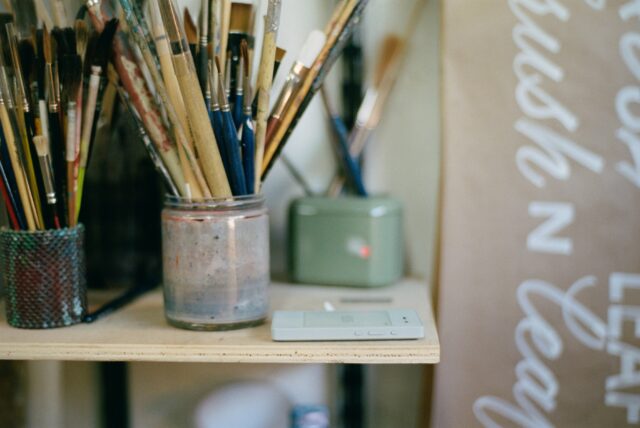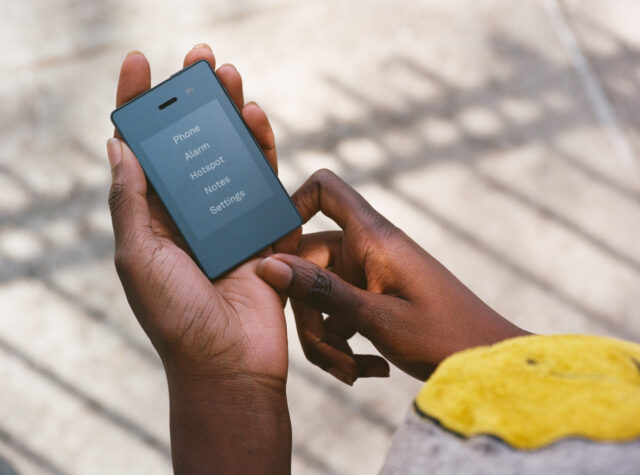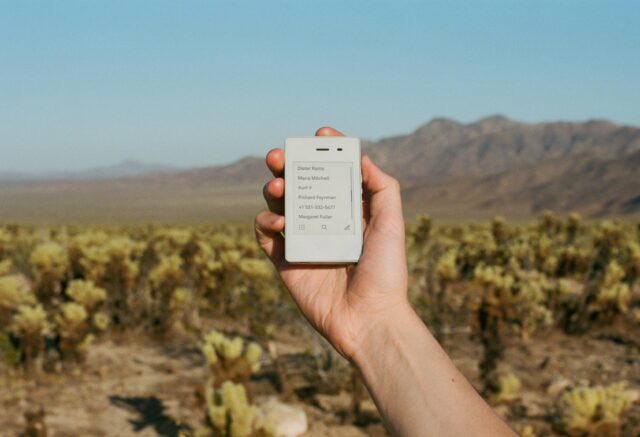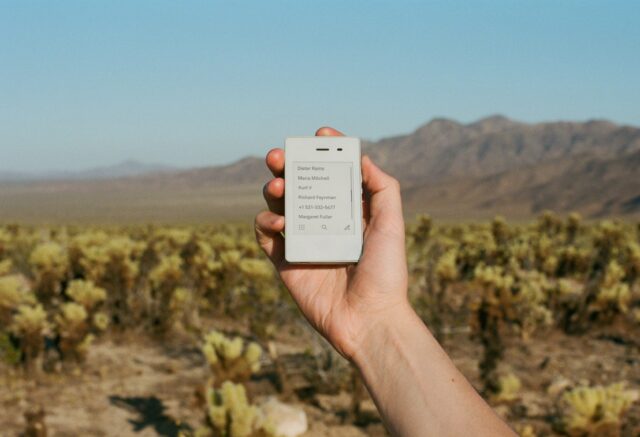Suddenly I feel both completely lost — and remarkably freed at the same time. I’ve spent the last hour setting up The Light Phone II, a credit card sized “dumbphone”. I’ve been sorting out the contacts I want to call and SMS, which podcast feeds would be useful and even which mp3s I’d like to upload.
But I can’t use the internet on this device. There is no Facebook to make me feel bad about my uneventful life. No X to doomscroll, no Instagram or TikTok content to absentmindedly browse. That “important” work e-mail is not nudging me for a response. Oh, and the weather? I just look outside the window. It’s sunny. Goodness, it feels great to be so… undistracted.
“People come to us saying they’ve had an epiphany,” smiles Dan Fox, who oversees marketing and partnerships at Light Phone. “I had one myself —I was at a concert and I just realized that my smartphone usage was literally ruining everything I held dear. Coming to work for The Light Phone, I wanted to make stuff that didn’t feed the ego, but fed a message. And that message is that we do need to separate smartphones from ourselves in our daily lives.”
The first Light Phone came about after artist Joe Hollier and product designer Kaiwei Tang met in a Google accelerator program in 2014 — ironically based around the techniques and psychology required to make apps ‘stickier’. They quickly realized working to keep people more immersed in their phones, for longer, didn’t really align with their vision of what quality of life actually means. With their combined skills — Tang had also worked on the Motorola Razr flip phone — they launched a simple Light Phone device via Kickstarter.

As they said at the time: “It represents an experience we call going light. It’s a way to enjoy quality time away from the pressures of the smartphone, doing whatever it is that you love to do the most, maintaining the peace of mind that you are still reachable.”
But it was very rudimentary, so in 2018 a similar campaign was launched for Light Phone II. Billed as a phone that could, through its tools and additional functions, actually be a life-changing, practical alternative to a smartphone, it made headlines recently when a special edition collaboration with Kendrick Lamar’s enigmatic multimedia company pgLang sold out in 10 minutes.
So while Light Phone II is actually over five years old now, it’s becoming increasingly visible, as more and more people come to the realization that spending so much time on smartphones is simply not healthy. According to the Data Reportal Digital 2023: Global Overview Report, the average mobile user spent five hours per day using their phone in 2022. Using analysis from data.ai, the report finds a seven-minute increase in that daily use from 2021, up to an estimated 30 percent of waking life.
“You know, that’s why don’t really like to call our device a dumbphone,” says Fox. “It’s fine, it’s become the terminology. But they way we look at it, because this device enables people to slow down and see what they have in front of them, it’s actually a smart decision to use one.”
And using it for a few weeks, it’s clear that Fox is right. It doesn’t take long for it to become a real relief — pleasure even — to live in the moment in this way. I stand in the school playground and speak to fellow parents rather than endlessly check my e-mails for messages I don’t need to read, ever, let alone right now.

One of the parents asks me how I’m doing, and rather than tell him platitudes, I actually engage with him and we both resolve to go for a coffee. At the coffee shop, my phone isn’t on the table, endlessly distracting me with unimportant push alerts. I listen. Later, I fall asleep to a podcast rather than mucking about on time-sucking apps for hours. The alarm function on the Light Phone wakes me up the next morning, and it’s the best night’s sleep I’ve had in ages.
I genuinely feel happier, less anxious, more in control of the way I navigate my life. If I need to know the news, then I can make a decision to watch it, or go on my laptop and look. Maybe even read the paper.
“The real tragedy of social media and smartphones is that no one’s really present,” says Fox. “We’re all trying to escape where we actually are. Which is actually a less-fun, less-engaged way to live. I always find it amusing to see people immediately reach for their phones in restaurants when their partner goes to the bathroom. That is totally normalized behavior now. But, maybe, just look around, see what’s happening, what people are doing. Look at the theatre of life.”
Lighthouse Arabia’s Dr Saliha Afridi speaks about digital mindfulness frequently. Like Fox, she has concerns that overconsumption of media and technology is disconnecting people with their true selves, and leaving no room for human experience. Afridi suggests switching airplane mode on more regularly as a counteraction to the all pervasive influence of apps. But for some, that isn’t — and won’t be — enough.
“We do actually have a lot of people come to us who have suffered with addictions — whether that be to their phone or in other areas of their life which smartphone usage has fed,” says Fox. “One guy told us Light Phone had not only saved his marriage but his life. And to read that in an e-mail stopped me in my tracks. Not only that we’d been able to affect one person so deeply, but more generally that people really need help with smartphones and social media usage.”
Interestingly, though, even Light Phone aren’t advocating complete digital abstinence. Dan and I have our conversation on Google Meet, which you can’t do on a Light Phone. Fox himself says that during the daytime, he might check in on WhatsApp on his laptop, or fire up Spotify.
“Switching to Light Phone II can be intense, because it’s a lifestyle change,” he admits. “And yes, sometimes our lifestyles won’t be compatible with going Light. Kaiwei likes to say that we don’t use the same pair of shoes for every part of our lives, so why do have the same phone for everything?

“So we do have a significant portion of people who use the phone as a secondary device; they just swap out their SIM cards when they need to be connected during the day, but on weekends and nights still use the Light Phone to disconnect. They might need an app on smart device when they’re travelling. We’re not saying delete everything and go and live off the grid.
“People confuse us for not liking technology, but actually, we built a phone. We’re big fans of technology! We’re just against technology that distracts, takes time and focus away from things that really matter in life.”
So with Light Phone, you can be in charge of how you navigate that digital world more healthily. You’re not going to be reading this story on a Light Phone, for example, although you could listen to the Livehealthy Podcast. And as the days pass, the more evangelical I felt, even though there were things I missed.
Which was, mainly, WhatsApp. (Less-used in the US, where Light Phone is based, it’s obviously a go-to for one-to-one messaging across the region)
I guess I could have just asked people to SMS me — and as Fox says, you can just have it on your desktop if you really need it.
Of course, Light Phone isn’t the only “dumbphone”. Nokia has relaunched many of its ‘old’ phones over the past 18 months, and somewhere between dumb and smart is the Nothing Phone 2. Nothing doesn’t mean no apps, just a simplicity in its UX encouraging more mindful use. iPhone actually tries this approach in some ways too — mainly by sending you horrific reports of your weekly phone usage that week.
And yes, the main counter to Light Phone or indeed any dumbphone is ‘why don’t you just take X and Facebook off your smartphone and block push notifications’?
“Good luck with that,” laughs Fox. “A lot of people try it. And kudos to you if you have that willpower, but a lot of people just end up surfing those apps on their web browsers anyway.”
As for the future, Light Phone is starting to develop a third phone, making it faster, easier to text, increasing the battery life and maybe even featuring a camera. However, it will be one that “develops” the images on a browser rather than encourages constant scrolling and editing on the device. All of which is in consultation with Light Phone’s genuinely useful and supportive online community.
“It’s funny, our user base is really broad,” says Fox. “We try not to be political ourselves, but on the left there’s much more attention to the cultural understanding that something is wrong with our mental health. While on the right, our users are more concerned about privacy, libertarianism, not wanting big tech to be seeing what they’re doing every day. Actually, that’s good, because it shows me that smartphone usage is an issue we all agree on — and that we have more in common than we think. Even if we’re coming to Light Phone for slightly different reasons.”
So of course some people will ask for Light Phone 3 to have Spotify or WhatsApp. But that’s not really the point. Ultimately, if you want to make serious changes to your digital lifestyle, then Light Phone II is a very appealing option. If I look back at my last two weeks with the device, it became less and less about what I’d lost — and more about what I’d gained.
“It’s a big leap to have that mindset,” agrees Fox. “But we’ve spoken to enough people who have bought our phones to know that this device does make a difference.”
Light Phone loaned a device for the purpose of this review.


